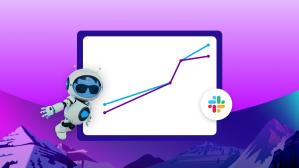Sonos, the brand best-known for multi-room wireless home audio, used to generate a large portion of its sales at brick-and-mortar stores. So when the pandemic hit and retailers shut down in March 2020, the company lost one of its traditional paths to consumers. At the same time, Sonos customer service agents had to quickly transition to working remotely full time.
With the help of Salesforce and Slack, Sonos was able to quickly pivot to focus on selling directly to consumers while also empowering agents to deliver a stellar customer experience from anywhere.
Sonos’ direct-to-consumer sales revenue increased nearly 47% during its 2021 fiscal year and represented 24% of total revenue. Meanwhile, Service Cloud workflows helped Sonos cut average support call time by as much as 10%.
We sat down with Ruth Sleeter, CIO at Sonos, to find out how the combination of Salesforce and Slack has been helping the company build a digital HQ and grow its success in a digital-first world.
Q. What challenges was Sonos facing before you embarked on your digital transformation?
Our service experience has always been about providing premium support for a premium product. We’d been growing significantly over the last few years, and after the pandemic hit, our customers were spending even more time at home with our products. We were doing a great job taking care of our customers, but wondered: How could we do it at scale and provide that effortless customer experience?
Meanwhile, our service specialists were suddenly doing their work from home full time. We asked: How do we make them most productive? How can we encourage them to feel really good every single day so they’d pass that goodness on to our customers? We wanted to lower the friction for both agents and end customers, at a time when we were all experiencing a lot of friction in our lives.
Q. How has Salesforce helped you innovate and scale?
Service Cloud helped us as we went through our transformation over the last year. We were able to deploy technology extremely fast, which meant we could scale our business in ways we wouldn’t have been able to imagine otherwise.
For example, introducing a chatbot into our service experience takes a tremendous amount of call volume away from our service specialists while helping customers quickly solve issues. With a chatbot, our agents can be analyzing the transcript as the interaction is happening to understand what products a customer is using, where they’re running into trouble, how we can help proactively, and maybe even what products would be a good fit for them.
Another area of innovation is around our telephony replacement, which we rolled out to nearly 1,000 agents across multiple countries in just a few weeks. We’ve automated workflows around call reception and dispatching, which allows us to focus our time on the things that computers can’t do, like complex problem-solving and building relationships with customers
Going forward, the tool will enable us to do real-time call transcripting, which enables our agents to pay attention to the customer, not the technology they’re working with. Sentiment analysis is incredibly helpful in improving our ability to be empathetic to customers and enhance their experience. And drawing on AI to recommend a next step to our service specialists complements the human touch and accelerates resolution.
Service Cloud is also built in a way that allows us to integrate our internal tools easily. That means our service specialists can immediately — at the touch of a button — get important diagnostics around what is going on with the caller’s speakers. And we can bring all of the technology, both internally and within Salesforce, to our service delivery specialists’ fingertips. That’s incredibly powerful for customers and will get us closer to our goal of delivering proactive and predictive service.
Q. Why should CIOs pay attention to building a Customer 360?
A 360-view across all different touchpoints of the customer experience is really important for us as a business. As CIO, I am responsible for delivering technology across the entire customer value stream. If I can draw from every tool and piece of data to build a holistic view of the customer, then different parts of the business can be on the same page and learn from each other. Combining all of this information in one place helps us understand the customer and do better by them, whether in driving sales, improving marketing, or providing effortless customer experience.
The customer doesn’t think about just needing service — they think about their entire experience with Sonos. So why wouldn’t we?
Q. What improvements did you see from digitally transforming your service operations?
We deflected 40% of cases that came to us through the chatbot, which means our customers are getting their answers faster. When they do call us, our agents are really able to focus on their problems, because they aren’t as pressured to be answering one call after another.
We’ve also seen gains in satisfaction among our call agents. As we rolled out the chatbot and Service Cloud, agents have become a lot happier with the tools they’re using, which has been really wonderful and that happiness passes to the customer.
Q. How are Service Cloud and Slack helping your agents work from anywhere?
With Service Cloud, we don’t have to worry about infrastructure or connectivity, which means we can allow our specialists to work from anywhere. As CIO, I can let go of some of that difficult work of managing infrastructure and work with our partners to make sure we’re delivering the right experience through a hosted application. It’s very freeing, and it makes it much easier to roll out technology faster.
We’re extreme adopters of Slack — it is in every part of our culture. The ability to keep connection open and enable collaboration among our employees has been incredibly meaningful and enabled a flexible work environment.
Q. Can you tell us more about how Sonos is using Slack?
We’ve adopted a Slack-first mentality: This has reduced the inefficiency of a cluttered inbox, while making it easy for distributed teams to do their jobs and collaborate from anywhere. Our teams often use Slack alongside customer data from Service Cloud, so they can make informed service decisions while swarming on cases.
Around 80% of our employees use apps in Slack to be more productive, and it has been easy to integrate with apps like Github, Google Calendar, Zoom and PagerDuty. We’ve created more than 200 Slack workflows to automate business processes, including those of the QA team. Plus, Slack Connect has made it easier to collaborate with external partners and vendors, reducing the need for managing third-party guest accounts. We’re connected to more than 20 external organizations so far, and the list keeps growing.
Q. Do you have any other reflections to share from the past year?
Sonos is focused on bringing joy into people’s lives, and I think we can be extremely proud that we’ve been able to do that in very difficult times. Ultimately, what makes my heart sing is helping people every day.
Being able to think about what our customers needed at every moment in time is what made us successful over the last year. As Sonos grows, we’ll grow even more in those abilities and really deliver the Sonos experience at every single moment the customer interacts with us. We couldn’t do it without partners like Salesforce and Slack.
For more information about Sonos, visit Sonos.com. To learn more about how Salesforce and Slack are helping companies build their digital HQs, read about the latest product integrations.
















